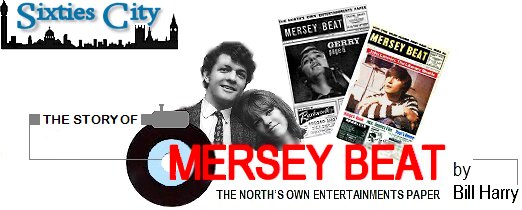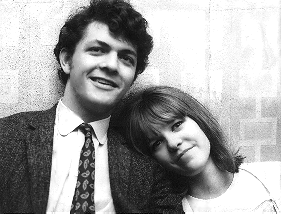 A special feature, originally exclusively created for Sixties City |
  Presented here, in his own words, is the definitive story of one of the Sixties' seminal music newspapers - providing a fascinating and unique personal insight into the early days of the 'British Beat Boom' and the events, personalities, facts and legend surrounding the birth of the greatest musical revolution the world has ever known. Bill Harry was the founder of the Liverpool music paper which chronicled the groups and venues responsible for the 'Mersey Sound', the publication which was to give its name to the Sixties phenomenon and musical era that has since become almost universally known as 'Mersey Beat'. |
|
Early in 1960 John Lennon, Stuart Sutcliffe, Rod Murray and I had
been to Liverpool University to listen to a poet called Royston
Ellis. We later retired to 'Ye Cracke' pub in Rice Street to discuss
the evening. The topic of conversation was that Royston was copying
the San Francisco poets rather than composing works in the British
tradition. We felt that any creative person should really base their
work on their own experiences rather than copying someone else’s
and the discussion led us to decide to work creatively on what we
knew best – and that was life in Liverpool. We decided to call ourselves
‘The Dissenters’ and made a vow that we would work creatively to
make Liverpool famous. John would do it with his music, Stuart and Rod with their painting and me with my writing. In some ways I suppose that could have been the spark that ignited my creation of 'Mersey Beat'. The four of us also used to hang around a coffee bar called 'The Jacaranda' in Slater Street, run by an ebullient character called Allan Williams. On the top floor attic of the building, which housed the 'Jac', was a young man selling second-hand albums. I used to chat to him and bought a copy of the ‘Picnic’ soundtrack. He was aware that I’d been assistant editor of 'Pantosphinx', the University charity magazine, and told me that Frank Hesselberg, who owned the Frank Hessy music store, had asked him to edit a magazine called ‘Frank Comments’ but he didn’t know how to go about it – would I do it with him? |
He introduced me to Mr Hessy and I got to work - designing it, writing for it and arranging for it to be printed at a local printing works, James E. James. I had a love of both writing and artwork and combined the two in creating magazines. Around that time I’d designed a magazine called 'Storyville/52nd Street' in the same format as the Hessy magazine. However, my taste in music had been turning from jazz to rock ‘n’ roll. John Ashcroft, a fellow student, had introduced me to Elvis Presley records and I used to go to a friend’s house to listen to Buddy Holly singles. With John and Stuart also being in a group, together with Paul and George from Liverpool Institute next door to the art school, I was more and more intrigued by this exciting sound which didn’t seem to get much airplay on BBC radio. We’d book John’s group for our Art College dances and at 'The Jac' I’d become friendly with members of 'Rory Storm & The Hurricanes' and 'Cass & The Cassanovas'.
 |
I’d
always carried little notebooks with me to write down information
and began taking note of the number of local groups I’d heard about.
At one time I wrote to the Daily Mail saying that Liverpool was like
New Orleans at the turn of the century, but with rock ‘n’ roll instead
of jazz. Of course, nothing ever came of that. There was no information about local groups in the Merseyside newspapers so, together with my girlfriend Virginia, I began to develop the idea of a ‘what’s on of music in Liverpool.’ Of course, being a student on a grant, I didn’t have enough money to produce it. Then I was approached by a friend, Dick Matthews, who had told an acquaintance of his, Jim Anderson, that I wanted to produce a publication. Dick introduced me to Jim and I described the project to him. He asked me how much I needed and I told him £50. He agreed to lend me the money and also secured me an attic room above David Land, the wine merchants, in Renshaw Street. Virginia gave up her job and became a full-time member of the newspaper. Jim and Dick helped us to move into the tiny top-floor room with Jim also providing us with a desk, chair and typewriter. Dick had a camera and became our first photographer. |
